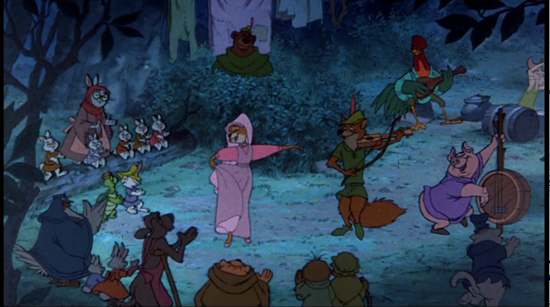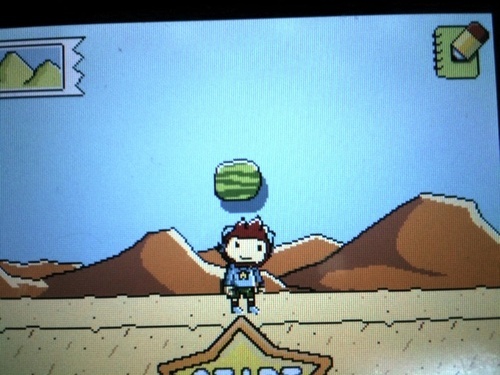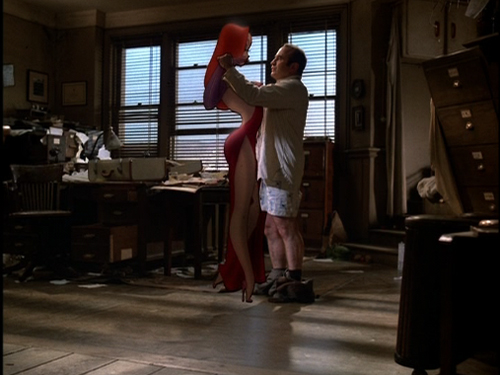Archive for September, 2009
CHILDHOOD REVISITED – DISNEY’S ROBIN HOOD
Posted by kjohnson1585 in Animation, Childhood Revisited, Film, Uncategorized on September 27, 2009
Disney’s Robin Hood – (1973)
Director: Wolfgang Reitherman
Starring: Brian Bedford, Phil Harris, Monica Evans, Peter Ustinov
Screenplay by: Larry Clemmons, Ken Anderson
There are more portrayals of Robin Hood then planets in the universe; the only character that may have more variations is Hamlet. And why not – Robin Hood is the unquestioning brave hero of the people, a thief of “socialist” pride, robbing from the rich and giving to the poor. Now, considering that, at this time, there was no such thing as a “middle class,” I don’t think socialism even applies here. Still, it’s the essence that Robin Hood represents that seems appealing. He’s not robbing the rich; he’s robbing the greedy, power hungry, corrupt rich.
Of course, it’s a tweaked story of sorts; the person in power is not the “real” king but an impostor; and once the real king regains his throne, the power struggle is made moot. The rich are still rich, and the poor are still poor, but this time, the rich have the poor’s interest in heart. So it’s not that Hood was fighting to equalize the socio-economic nature of feudalism; he was being a crook until he got someone he liked. What does this tell us about today, about the public’s perception of a crooked Wall Street and a screwed-over public? What could be argued concerning Obama as the “Savior” of the people? Where is our Robin Hood of today? It’s interesting to watch this now, a movie from the 1970s, when there was another recession going on at the time.
But it’s a Disney cartoon, so let’s focus on that, shall we?
NOSTALGIC LENS: Disney smooth and more realistic depiction of anthropomorphic animal characters allowed for more character to be depicted than Warner Brothers’ or MGM’s wackier, just-for-laughs band of reprobates, and while I can’t say I liked one over the other, I can say I enjoyed them in different ways – two sides of the same coin, as it were. I enjoyed Robin Hood and its controlled pacing and enjoyable atmosphere, but while there’s nothing amusing about it, it seemed to have something going for itself, unlike the “padding for an hour before we pull the sword” nature of Sword in the Stone, or the “write everything just so it leads to ‘Everybody Wants to be a Cat’ song” in The Aristocats (and, uh, I don’t want to be a cat.) I have no idea if it holds up, though.
DOES IT HOLD UP: Robin Hood’s greatest strength is how organic it seems. There’s a sense that this world exists and its characters exist in it, and it completely lacks any indication of self-awareness. In other words, at no point does the movie imply that “this a movie with animals in it, and gosh darnit, ain’t they cute”? I can’t say for sure other movies that delved into any form of anthropomorphism had that controlled sense of itself. The Rescuers films made it aware by depicting the humans around them; so did An American Tail and its follow-up. Even modern films, such as The Chronicles of Narnia, seem to film around its CGI creatures with an obvious sense of self-recognition, as if to say, “See these cute animals do people things!”
That in itself says a lot, and even if it misses out on many of the generic Robin Hood staples, it breathes a life on to its own. Even the more outlandish moments seem to fit, as when Robin and Little John raid the royal caravan dressed as gypsies (with the hundreds of guards not noticing) and an elaborate, chaotic scene when a conflict breaks out at an archery contest. It comes together surprisingly well.
There’s nothing new to the plot here that isn’t in a hundred different Robin Hood tales. Greedy Prince John assumes power as the real King Richard disappears in the Crusades, taxing the poor with the Sheriff of Nottingham enforcing the law. Robin, in his good nature, robs the rich to provide for the oppressed, and a lot of various events happen when Robin tempts fate, gets caught, fights his way out, and eventually wins everything—the money, the girl, the battle, the contests, and so on.
With its dark but rich, detailed animation, awkward writing moments pass by as the characters and scenes fluidly move from moment to moment (although I think I caught a 5-fingered or 4-fingered moment on the Sheriff), which certainly helps legitimizing this world of animals. (In fact, the only out-of-place moment occurs during the opening credits, where the characters are introduced like “Robin Hood – A FOX” and “Maid Marian – A VIXEN”. Just in case, you know, you can’t tell what animals they are.)
In fact, the dialogue runs the risk of over-exposition, especially when Prince John and Sir Hiss over-explain pretty much every plot moment that occurs (including a silly scene where John just tosses money in the air yelling “Taxes! Lovely taxes!” I love how movies blindly make taxes the MacGuffin of evil, completely forgoing it’s purpose or reason in the economic stability of a region). But where it fails there, it makes up it with some amazing acerbic wit, as this exchange shows:
FRIAR TUCK: … someday you’ll be called a great hero!
ROBIN: A hero? Do you hear that, Johnny? We’ve just been pardoned!
LITTLE JOHN: Oh, that’s a gas. We haven’t even been arrested yet!
Well, I laughed.
The introduction showcased here shows both the movies strengths and weakness in one go:
But when the movie hits its stride and moves away from its more awkward moments, it becomes something real. This love montage sequence pretty much sums up the movie’s naturalism:
(Note 0:35-0:45. The poses, movements, and gestures in oh-so-subtle ways epitomize how organic everything is.)
IN A NUTSHELL: While I didn’t love it, you can’t deny how enjoyable it is, and how rich the details make Robin Hood breathe its own life. Early in the movie, a few kids sneak into the palace grounds, where Maid Marian and Lady Kluck have a lot of fun messing and playing with them. It’s a nice moment, two separate socio-economic classes coming together under a sense of oppression to enjoy themselves after being so isolated. And the beautiful animation, of various angles and playful banter just pushes it to almost a thing of art. Most “slice of life” live films lack that sense of control, especially with children involved, and considering that this movie continues that throughout its entire run, you almost have to admit that it’s a thing of art.
October 5th: Theodore Rex
October 12th: The NeverEnding Story
BLACK MAN RAGE – “WHAT DA PROBLEM IS?” #2
Posted by kjohnson1585 in Uncategorized, Video Games on September 24, 2009
Somebody call Al Sharpton up in this bitch.
As you may or may not have heard, 5th Cell’s hotly-anticipated (but mediocre-reviewed) game Scribblenauts apparently is purely and unabashedly racist. For you see, if you type in the word “sambo,” a watermelon pops up on the screen. I assume it’s not seedless and warm, and probably lacks vodka.
Of course, 5th Cell, who’s name I assume designates where they believe all black people should belong, denies that such a feature was intentional. Sambo, in Ecuadorian, refers to some fruit that only resembles a watermelon.
Oh, LIKELY story, 5th Cell. I assume they all saw this (absolutely hilarious) cartoon by Tex Avery:
… while masked and/or shaving their heads and thought this would be okay.
Well, I assure you, this is NOT.
The ‘sambo-leads-to-watermelon-and-perhaps-KoolAid’ picture, however, isn’t really the problem that black people have with it. As a black man, one who speaks for ALL OF THEM, I assure you that most of my brethren (kats? dogs? my ni**as? They keep changing out collective name) care little, if at all about this controversy, almost as much as they care about the controversy surrounding the African zombies in Resident Evil 5. (Wait– zombie-causing virus hits an African tribe, and the zombies they produce happen to be black?! Did they port Birth of a Nation to the Wii!? Can my grandmother play this?!)
Of course they don’t care. Black people only care about two video games:
1) Madden
2) The next Madden
No, we’re up in arms (you know, the ones that Obama took away, but didn’t take away, which inevitably led to a severe shortage of bullets) because sambo seems to be the only potentially racial gimmick in the game!
Now, sure, it you look at the 200-plus comments in that Destructoid link, a load of people didn’t seem to realize that sambo could be perceived as racist. Imagine! Kids today, running around as they stuff Big Macs and candy and Big-Macs-stuffed-with-candy into their mouths, playing a DS in one hand and a PSP in the other, blindly asking that sambo janitor to clean up their mess. Because, gosh darnit, they just didn’t know! We perverted their innocence, and thanks to 5th Cell, President Sambo is now a JOKE THEY WILL USE (presumably shouting this out at a town hall meeting, or Congressional session, or some other ill-advised political locale, along with socialist, communist, birth certificate, and other “way too big” words for them to be using).
“But,” they will say as they smear their greased-soaked digits on their keyboards when they finally realize how shitty Crysis really was, “if sambo is a word I can use now, safely and without harm, then what about the deliciously antagonizing vocabulary slang such as kike, wop, nip, spic, and so on? If I type in cracker, and a literal cracker pops up on screen, should I get angry and riot and/or flood my own city?
I say to you: YES. We blacks and whites have be represented (wut wut!) but my fellow minorities have been shafted their chance at video game recognition. So stand up, Scribblenauts in hand, and throw it away (after, of course, getting frustrated at its insane difficulty level) and instead, insert the race card! You know, that multi-player game of choice we all play when we get (or don’t get) what we want! It’s all or nothing, 5th Cell! You best think about that when you make the inevitable sequel, or we’ll try twice as hard to sit idly not caring as dollar bills rain down when you type “Kosher” or your character self-destructs when you type “Arab” or “Indian,” because, well, they just look so much alike!
Now, if you excuse me, I’m eagerly awaiting Madden 2011.
CHILDHOOD REVISITED – WHO FRAMED ROGER RABBIT
Posted by kjohnson1585 in Animation, Childhood Revisited, Film, Uncategorized on September 21, 2009
Who Framed Roger Rabbit – (1988)
Director: Robert Zemeckis
Starring: Bob Hoskins, Christopher Lloyd, Joanna Cassidy, Charles Fleischer
Screenplay by: Gary K. Wolf, Jeffrey Price, Peter S. Seaman
Robert Zemeckis, in my opinion, was one of the best, most accessible directors to ever grace Hollywood screens. Most directors excel at one (or a few things) while falling short in other areas. Zemeckis, however, seemed to really know how to deliver a movie that was both thoroughly entertaining AND rich in content. He was, in a sense, a James Cameron-lite: while Cameron excelled at the big, beautiful blockbuster, Zemeckis excelled at smaller (if still expensive) family, heart-warming fare.
Some of his best works, like Back to the Future, Who Framed Roger Rabbit, Forrest Gump, and Cast Away, utilize a seamless, almost-perfect blend of special effects, fine acting, strong symbolism, solid direction, and beautiful set design. Nothing pushes into the artsy realm like a Kubrick or Malick film; but when he brings the love, Zemeckis brings the love. (While movies like The Polar Express, Beowulf, and Contact may not have the idyllic temperament that his other movies have, they still are competently done; it’s the writing that usually falls short in that regard. Although I will admit that he is somewhat slipping nowadays, like so many infamous 90s directors.)
How awesome is Zemeckis? Take note of this awesome bit of trivia taken from IMDB.com concerning today’s feature: “The first test audience was comprised mostly of 18-19-year-olds, who hated it. After nearly the entire audience walked out of the screening, Robert Zemeckis, who had final cut, said he wasn’t changing a thing.”
Motherfucker knows what’s up.
NOSTALGIC LENS: Prior to the overwrought and somewhat overdone love for bizarre crossover video game Kingdom Hearts, this, my dear readers, was probably the most awesome-est crossover thing to ever awesome an awesome. Bugs Bunny AND Mickey Mouse in the same film? Kid-mind-orgasm. With a host of amazing and all types of animated characters interacting with live humans, this here was the true fantasy of every child (sorry Goonies, treasure hunting ain’t got shit on this). Also, it helps that the film was well done with competent actors. While I may not have fully understood the plot or the setting, you still had to love the frantic pace and the perfectly, in-character toons.
DOES IT HOLD UP: People, c’mon. Disney bought Marvel, but while you whine about their child-friendly image effecting everything, you’re forgetting that, indeed, Disney can also be very, very badass. They won’t put the “Disney” name on it (this movie is produced through Amblin Entertainment and Touchstone Pictures, which are owned by Disney), but they’ll definitely bring the noise (like in the aforementioned Kingdom Hearts).
This movie is a delight. Fun, frantic, hilarious, and intriguing, Who Framed Roger Rabbit exploits the 1947 time-period with seamless interaction with animated figures so perfectly, there are hardly, if any, awkward moments. It’s the richness of Chinatown with heart of Disney cartoons and the funness of Looney Tunes (and a bit of Tex Avery—but all cartoons have a bit of Avery).
Private eye Eddie Valiant is tasked with taking “risqué” pictures of Roger Rabbit’s wife and Marvin Acme, owner of Toontown. The paddie-cake photos cause Roger to lose it and, suddenly, Acme is dead. People all over town blame Roger for the murder, and it’s up to a reluctant Eddie to return to the world of toon-crime solving to clear Roger’s name.
Why is Eddie so reluctant? A toon killed his brother. Pretty harsh, I know, but the movie spares no expense in this regard. If you ever saw Chinatown or LA Confidential, you may have an understanding of this moment in American history, of the power of the paparazzi and stardom, of studio control and the relationship of this to the public, private, and government sectors.
I included this clip specifically for 7:30 – 8:30, one of the best, heartwarming, and underrated tracking shots in film history. Zemeckis shows an incredible amount of control in this film, maintaining the perfect blend of wackiness and seriousness; no scene is awkward or out-of-place (like numerous moments in Space Jam), and we as viewers are easily brought into this parallel world of cartoon stardom and the seedy underbelly of the Hollywood that controls them.
I especially love the attention to the details. Along with the costume and set designs, little bits here and there jump out, like the general lack of concern for Eddie’s drinking problem (there’s no AA in 1947; no one cares, and they even have a few jokes at his expense). All complemented by a powerful score by Alan Silvestri and the incredible hard work by the animators and the special effects crew, there’s very, very little to hate about this movie.
And speaking of the animators: of course, I can’t do a review of this movie without noting the amazing cartoon characters themselves. It’s a grab-bag of classic characters, both minor and major, and audience members will have a blast just pointing out every one they remember. But no one character seems forced in any scene; they fit like a glove, and the fact that the humans and toons interact comfortably, as if it was always like this, really gives this world and, consequently, the movie, it’s heart.
Of course, the most iconic of the characters appear, and they indeed steal the show:
“They never get to finish the act!”
“Ya, you could get killed!” Cue Mickey’s laugh.
If I had to choose some flaws in this movie, I would say that the actual mystery here isn’t really all that complex. In fact, it’s kind of simple, and the actual resolution hardly takes any time. But the moments that Who Framed Roger Rabbit does include are special and hilarious, and rather inspiring. I could imagine that the legal considerations was a nightmare (in fact, Popeye and Felix were to appear but the rights weren’t secured in time), but when a director has the passion and vision to prevail through the odds and bring about a spectacularly enjoyable crossover of such epic proportions, you know you have something special on your hands. (Watch the movie on Youtube to find out whodunit, although, the real culprit is obvious – and yet, the twist behind it may not be as much.)
IN A NUTSHELL: I once irritated my ex when we watched this movie together by quoting lines before they were actually spoken. With such an infinitely quotable script, how can you not? If there’s anything you can take from this movie, is that deserves a serious amount of respect (there were no CGI or computer-use whatsoever). But it’s a wonder and a treat: parents, at the very least in the midst of your over-protectiveness, let your children see this.
September 28th: Robin Hood
October 5th: Theodore Rex




